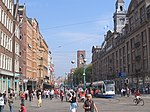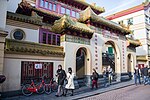Warmoesstraat
Netherlands road stubsStreets in Amsterdam

Warmoesstraat ('Chard Street') is one of the oldest streets in Amsterdam, running parallel to Damrak from Nieuwebrugsteeg to Dam Square. Its origins are in the 13th century. In the 16th and 17th century it was the shopping street. The poet Joost van den Vondel sold silk stockings here.Today, the busy Warmoesstraat has a variety shops, bars, restaurants, cheap hotels, coffee shops and sex boutiques. The artist run W139 art space is also located on this street. It is located adjacent to the red-light district. The Warmoesstraat-area is also known as the Leather area as there are many cruise and fetish bars and bars with darkrooms.
Excerpt from the Wikipedia article Warmoesstraat (License: CC BY-SA 3.0, Authors, Images).Warmoesstraat
Warmoesstraat, Amsterdam Centrum
Geographical coordinates (GPS) Address Nearby Places Show on map
Geographical coordinates (GPS)
| Latitude | Longitude |
|---|---|
| N 52.375481111111 ° | E 4.8980555555556 ° |
Address
Warmoesstraat 50R
1012 JE Amsterdam, Centrum
North Holland, Netherlands
Open on Google Maps










